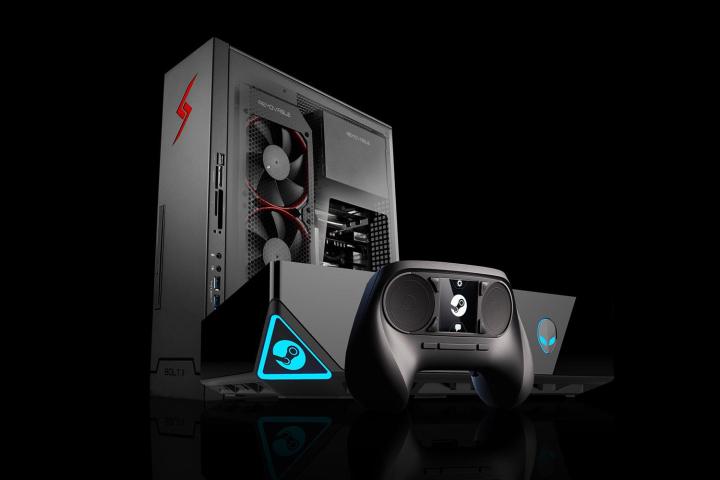
I don’t know about these Steam Machines. And after attending Valve’s CES 2014 press event, I’m not entirely sure the Steam gatekeeper does either. Moreover, I think that’s the whole point right now. We’re all asking the same question: What exactly is a Steam Machine? I think Valve is too.
Let’s look at what we know: There are two defining features for every Steam Machine, two elements that elevate it beyond a mere gaming PC: SteamOS and the Steam Controller. Take those away, and you’ve just got a computer capable of playing video games. Even the Steam branding that adorns many of the third-party boxes we’ve seen so far appears to be entirely optional.
We’re all asking the same question: What exactly is a Steam Machine? I think Valve is too.
SteamOS is in slightly better shape. Slightly. The core framework that resembles Steam’s long-since-released Big Picture mode is there, but it immediately feels only halfway baked when you use it. SteamOS – which was released as a free download in December 2013 – is still in beta, with Valve recommending that only the Linux-proficient make use of it for now. It’s got a ways to go.
Even the boxes themselves aren’t fully realized yet. The third-party Steam Machines on display at Valve’s CES event were largely just empty shells. Alienware’s sleek, compact box was nothing more than a housing for colored lights. Digital Storm’s Bolt II is supposed to be out later this month, but the core components that make it a Steam Machine – the controller and the operating system – are still in development. The boxes that do work are gaming PCs with the potential to be Steam Machines; be very clear on that before you consider purchasing one that may be coming in the near future.
I look at all of this, and I can’t help but think it’s part of a longer-term plan that people aren’t seeing right now. Valve is angling to establish a presence in the living room by proxy through third-party manufacturers, and perhaps with its own, internally developed hardware further down the road. But the Steam Machine as we currently understand it doesn’t really seem to be successfully targeting any specific audience.
The majority of hardcore PC gamers aren’t going to rush to embrace SteamOS, or even try it in a dual-boot environment, when roughly 90 percent of what’s available for Steam via Windows isn’t yet supported by SteamOS. That’s hundreds of titles. How many can realistically be ported over to Linux by the end of 2014?
Steam newbies and entrenched console gamers are also left out. The diminished library compared to Windows and even Mac is a concern for those people too. There’s nothing to sell a newcomer on PC gaming, especially not now with stuff like Sony’s game-streaming PlayStation Now on the horizon. You don’t even need a console for that.
The boxes that do work are gaming PCs with the potential to be Steam Machines.
That leaves the Steam diehards. The tech-savvy fanfolk that don’t mind messing with incomplete tech if it means they can be among the trailblazing first adopters. They’re the beta testers. Even if they’re not among Valve’s lucky 300 first-party Steam Machine users, they’re the people that will help shape whatever form the finished product will take.
The question remains though: What is the desired goal here? What is Valve’s long game? Will these third-party partnerships help the company to crystallize its own nascent development of first-party Steam Machine hardware? Or can we chalk this entire initiative up to the outspoken Gabe Newell’s resistance to Windows’ closed garden by pushing Steam and its 65 million users towards Linux?
The ultimate answer may lie at the $500 price point, in the hardware that competes directly with the dominant consoles in dollar value. It’s hard to envision $500 worth of gaming PC directly challenging the capabilities of the PlayStation 4 or Xbox One in January 2014, but what about January 2015? Consoles are always restricted by the limits of their unchanging hardware over the course of a generation. PCs aren’t.

A competitive landscape for Steam Machines will drive the price of the hardware down to some extent, but Valve’s staunchest ally is simply the passage of time. The PS4 and Xbox One are fitted with cutting-edge tech right now as they stack up against currently available PC hardware. By 2015, that sense of parity will shift to give PCs the advantage. By 2016, it will have shifted even further. It’s the nature of a console generation.
Yes, Steam Controllers and SteamOS need plenty of work before they’re ready, but that $500 price point is going to get you a whole lot more gaming power by the time they are. It’ll be enough by 2015 certainly to exceed the capabilities of our freshly released consoles.
Make no mistake, the pretty boxes on display at CES are meant to distract you. We may well have gotten our first glimpse at the lineup of Valve-approved Steam Machines, but it’s important to remember that Steam’s sleek living room future isn’t as close at hand as it seems.




